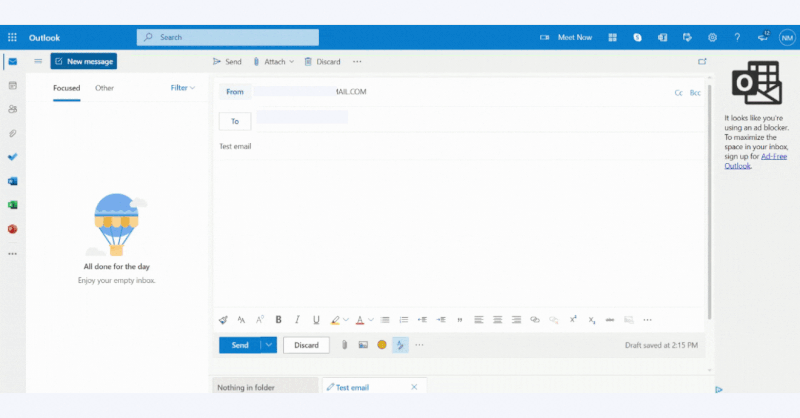Adding attachments in an email can be a valuable communication tool as you can convey and showcase the information that you can't put in the email body, such as your portfolio work.
But, attachment in email suffers from many drawbacks that might cause problems for you. But we are here to help. We will discuss the major pitfalls of email attachments and discuss best practices to leave a great impression on your recipients.
Table of contents
- What is an email attachment?
- What types of attachments can you send?
- How to write an email with an attachment
- Drawbacks of sending attachments in emails
- Best practices for sending attachments in emails
- Wrap up
What is an email attachment?
Email attachment is a computer file that you can send with an email message. You can use different formats to showcase your attachments such as .doc, .pdf, .jpeg, .xls, etc.
For example, if you want to showcase your work to potential clients, you can add your portfolio in your cold email. That portfolio file will be the email attachment.
What types of attachments can you send?
Different types of attachments you can send in the email are
.doc or .docx: For sending text files with images. For example, MS Word and Google Docs
.pdf: For sending a formatted text with images that the recipient can easily access irrespective of the operating system, application software, and hardware.
.ppt or .pptx: Use this format to send slideshows and presentations.
.xls: For sending database in row and column format. For example, Excel sheets or google sheet files.
.png, .jpeg, or .gif: Use this format to send static and animated images.
How to write an email with an attachment
The steps to writing an email and attaching files are similar across email clients with slight variations. We will discuss the steps to write and send emails with attachments in Gmail and Outlook to give you an overview.
Steps to send emails with attachments in Gmail (PC)

Source: Google
On your PC, go to Gmail.
Click Compose, a pencil-like icon in the top left corner.
After composing your draft, click Attach.
Choose the files you want to upload.
Click Open.
Then preview your emails and send it.
Steps to send emails with attachments in Outlook

On your PC, go to Outlook.
Click New Message.
After composing your draft, click Attach. You can find this option at the top of emails and the button near the send button.
Choose from the dropdown:
Browse this computer: To upload files from your computer
Browse cloud locations: Upload files in your OneDrive
Upload and share: Select the file from your devices and share it to the recipient's OneDrive folder.
Drawbacks of sending attachments in emails
Here are some of the drawbacks of sending emails with attachments that you should know about:
1. Most phishing attacks happen via attachments
Email attachments are still the main method attackers use to deliver malicious programs to your devices. Attackers use social engineering to manipulate readers to open an attachment that might infect their device with malware or virus. There are measures you must take to avoid such scenarios.
To know about them, read our guides:
How To Detect Phishing Emails And Safeguard Against Them
What Is Email Spoofing and How to Safeguard Against It
2. Limited file size support across email clients
Email clients limit the maximum file size you can send or receive to avoid overloading the email servers. If an email server is overloaded, then it ceases to work smoothly. Hence, every email client puts some limitations on attachment size. Such restrictions may limit the file size you can send via emails.
Maximum file sizes for the most widely used email clients are given in the table:
| Email clients | Maximum file size limit |
|---|---|
| Gmail | 25 MB |
| Microsoft Outlook | 20 MB |
| Yahoo Mail | 25 MB |
| iCloud Mail | 20 MB |
3. Attachments may trigger spam filters
Since attackers use attachments to deploy phishing attacks, many spam filters detect emails with attachments as spam and land them in the spam folder. But, such incidents occur when you send an email with attachments in bulk or use spam trigger words as attachment names.
If your emails land in spam, it means lower deliverability and thus reduced open rates and click-throughs.
Let’s discuss best practices to send attachments in emails to deal with these drawbacks.
Best practices for sending attachments in emails
Before sending attachments in emails, consider these best practices:
✅ Use cloud storage to send large file sizes
If you send attachments that exceed the limit supported by email clients, then use the following methods to send them:
- Zip it
One of the easiest ways to send large files or a collection of little files is to compress them. Doing so won't affect the file but only reduce the overall size to send it easily. On your laptop, right-click, and you'll see an option to "compress." It will create a compressed file with the same name and a .zip extension. You can even create subfolders within the same folder and then zip it.
- Share via Google drive link
While composing an email, you get an option to attach Google drive links to your emails. This way, you can send emails that exceed the 25MB limit by Gmail. You can either attach a link that will lead to the file in the Google Drive folder.
- OneDrive: For Outlook users
Upload your files in OneDrive if you use Outlook to send attachments exceeding the 20 MB limit.
- Dropbox
Dropbox is another handy tool you can use to send large attachments. Upload your files to your Dropbox account, and with the Dropbox extension, you will get the option to attach links within the email. With a free Dropbox account. You can send files of size up to 2 GB.
- iCloud Mail Drop for Apple users
If you are an Apple mail user, the iCloud Mail Drop can help you send file sizes up to 5 GB. When you send a file size of more than 20 MB, Maildrop automatically comes in. It uploads the file to an iCloud email server, attaches a link, and creates a link. The link will auto-expire after 30 days.
✅ Use links instead of attachments
If you can, add links to the source instead of a file. It will navigate users to a webpage where they can easily access the entire content. Adding links also reduces the probability of landing in the spam folder.
✅ Use an accessible file format
If you send a word file, the recipient needs to have Microsoft Word to view that file. If they don't have it, accessing your files will be difficult. So, use a format that is easily accessible, such as PDFs.
✅ Name email attachments properly
You should name email attachments so that recipients know what is in the file and avoid spam filters. We have a few suggestions to do that:
Avoid using too long names
Don't use special characters or emojis such as *, ", #, @, ✔, ➕, etc.
Give a descriptive file name. Avoid: 4565_Finalcontent_21. Use Contentbrief_(date)
Wrap up
Sending email attachments can help you convey valuable information, but you should do it with precaution. Like your email copy, files should also offer information and add value. Recipients should be clear about what they can expect when they open the file. And whenever possible, use links instead of a file to reduce the chances of landing in the spam folder.

